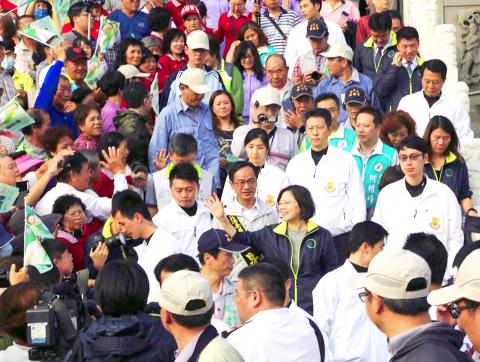More than 350 candidates are to vie for 73 directly elected seats in the legislative elections on Saturday next week, the Central Election Commission announced yesterday.
A total of 354 legislative district candidates have registered to compete in the nation’s 73 electoral districts, a number that is more than 30 percent higher than the 269 candidates who competed in the 2012 elections.
Several new parties have also nominated candidates to run in the legislative elections, including the New Power Party, the Republican Party, and the Faith and Hope League.

Photo: CNA
Many of the parties were formed last year out of disappointment with the performances of larger parties.
The Legislative Yuan has a total of 113 seats. In addition to the 73 legislative seats up for election in “first-past-the-post” campaigns, there are six seats reserved for Aboriginal candidates and the remaining 34 seats are for legislator-at-large candidates.
There are 23 Aboriginal candidates competing for the six seats.
The legislator-at-large seats are to be allocated in proportion to the total number of votes a party gets, but it must receive at least 5 percent of the vote to qualify for a seat.
A total of 18 political parties are competing for legislator-at-large seats, including the Chinese Nationalist Party (KMT), the Democratic Progressive Party (DPP), the Taiwan Solidarity Union (TSU), the People First Party (PFP) and the Non-Partisan Solidarity Union — all of which are now represented in the legislature.
In 2012, only 11 parties nominated candidates for legislator-at-large seats.
Because of the large increase in the number of participating parties, the size of the ballot paper to be used in the vote has increased to 73cm long and 15cm wide.
In the 2012 legislative elections, the KMT won 64 seats and the DPP garnered 40 seats. The PFP and TSU each won three seats, while the Non-Partisan Solidarity Union won two and the remaining seat went to an independent.

The disruption of 941 flights in and out of Taiwan due to China’s large-scale military exercises was no accident, but rather the result of a “quasi-blockade” used to simulate creating the air and sea routes needed for an amphibious landing, a military expert said. The disruptions occurred on Tuesday and lasted about 10 hours as China conducted live-fire drills in the Taiwan Strait. The Civil Aviation Administration (CAA) said the exercises affected 857 international flights and 84 domestic flights, affecting more than 100,000 travelers. Su Tzu-yun (蘇紫雲), a research fellow at the government-sponsored Institute for National Defense and Security Research, said the air

Taiwan is to commence mass production of the Tien Kung (天弓, “Sky Bow”) III, IV and V missiles by the second quarter of this year if the legislature approves the government’s NT$1.25 trillion (US$39.78 billion) special defense budget, an official said yesterday. Commenting on condition of anonymity, a defense official with knowledge of the matter said that the advanced systems are expected to provide crucial capabilities against ballistic and cruise missiles for the proposed “T-Dome,” an advanced, multi-layered air defense network. The Tien Kung III is an air defense missile with a maximum interception altitude of 35km. The Tien Kung IV and V

Trips for more than 100,000 international and domestic air travelers could be disrupted as China launches a military exercise around Taiwan today, Taiwan’s Civil Aviation Administration (CAA) said yesterday. The exercise could affect nearly 900 flights scheduled to enter the Taipei Flight Information Region (FIR) during the exercise window, it added. A notice issued by the Chinese Civil Aviation Administration showed there would be seven temporary zones around the Taiwan Strait which would be used for live-fire exercises, lasting from 8am to 6pm today. All aircraft are prohibited from entering during exercise, it says. Taipei FIR has 14 international air routes and

Taiwan lacks effective and cost-efficient armaments to intercept rockets, making the planned “T-Dome” interception system necessary, two experts said on Tuesday. The concerns were raised after China’s military fired two waves of rockets during live-fire drills around Taiwan on Tuesday, part of two-day exercises code-named “Justice Mission 2025.” The first wave involved 17 rockets launched at 9am from Pingtan in China’s Fujian Province, according to Lieutenant General Hsieh Jih-sheng (謝日升) of the Office of the Deputy Chief of the General Staff for Intelligence at the Ministry of National Defense. Those rockets landed 70 nautical miles (129.6km) northeast of Keelung without flying over Taiwan,